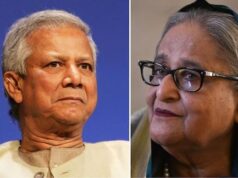Nepal’s National Symbols: Under self inflicted perfidy?
“Symbols are important, because they are the visible signs of invisible realities”—Saint Augustine

By Colonel Satish Singh Lalotra
Symbols and the human evolution have a long drawn association that dates back to the cave man days of our ancestors. Symbols became more salient to the human eye , increasingly expressive of human intent and identity , and easier to reproduce from memory from the time ‘Homo sapiens’ left his cave existence and started dwelling in a more organized manner. The earliest known religions viz ‘Bon’ which has a close relationship to that of Tibetan still practices the centuries old tradition of associating their animistic Gods with that of symbols. Being an animistic religion, Bon followers ascribed a definite symbol to each of their Gods that derived their strength from plants, animals and other natural objects like the sun, moon etc firm in their conviction that these possessed a living soul.
Even our Hindu mythological treatises like the Mahabharata and the ilk had profusely depicted symbols on the various pennants that the warriors flew on their chariots while engaging in the battles of Kurukshetra that had a mesmerizing effect on their armies and tilted the fortunes of war. The organization of world order centuries back based on clans, language, race into countries raised the need to identify these geographical entities by way of their national symbols which spanned an entire spectrum ranging from the national flag, currency , national animal, flower, parliament, map and so on. Each had a distinct stamp of approval of the citizens of that particular country ratified by the highest sovereign body of that country, namely the parliament which reflected the will of its people. These symbols were later given due recognition by the world body/ comity of nations thus putting a stamp of approval on these symbols as having gained worldwide assent.
Off late this assent has become a bone of contention amongst many nations of the world where the national symbols of a particular country has had a deleterious effect on a neighbouring country’s foreign relations. The latest to rock the boat of foreign relations amongst neighbouring countries which has stirred a storm in a tea cup has been the national parliament of Nepal as well as its national map and now the national currency which surreptitiously has given a tacit approval of its intention of cartographic aggression against India. The decades old territorial imbroglio between India & Nepal which has its origins tracing back to the 1816 ‘Treaty of Sigauli’ signed immediately after the Anglo- Nepal war has been in and out of the national mainstream of both the countries and yet queering the pitch in many ways than one.
It was not as if India was found wanting in laying its claim in this strategic tri-junction region of India, Nepal and Tibet (China), but the fact that our laying of territorial claims was half –hearted and backed by a Geo-political naivety in the past would not sound far-fetched to even a lay man reading these developments with an ear to the ground. Though the imbroglio gained traction since 1997 during the tenure of the then PM IK Gujral of India on his official visit to Nepal wherein he gave a tacit carte blanche to Nepal for claiming this Tri-junction area; Nepal became more vociferous and vehement in its claims in the first half of 2020 when the pandemic was at its peak. It was in the first half of June 2020, when the Nepalese parliament unanimously passed the amendment to include the new political map featuring areas of Lipulekh, Kalapani, and Limpiyadhura in the constitution of Nepal.
This controversial bill was passed with a majority of 258 votes (out of 275), while no member voted against the bill. A 2/3 majority of the 275 member lower house was required to pass the bill. Major opposition parties including Nepali congress (NC), Rashtriya Janata party –Nepal ( RJP-N) and RPP( Rastriya Prajatantra party voted in favour of the government bill to amend schedule 3 Of the constitution to update the national emblem by incorporating the new controversial map. The bill having gone to the national assembly and the president having passed it in toto, has become a reality with the foreign minister of Nepal stating later that Nepal’s new map would be permanent and that there is no room for change. The latest whammy to hit the foreign as well Geo-strategic relations of both the countries was the imprinting of these three disputed areas of Lipulekh, Kalapani and Limpidhyura on its 100 rupees note.
With the national currency of Nepal now in league with the detractors of India it is abundantly clear that the national symbols of Nepal viz their parliament, maps/ survey of Nepal and the central bank of Nepal all are working in sync to legitimize an area that has long been part of India following the basic tenets of ‘Long usage’, revenue records of district Pithoragarh, as well as the treaty of Sigauli signed in 1816 between British India and Nepal after the end of Anglo-Nepalese war in 1815. The fact that Nepalese rupee( NPR) administered by the central bank of Nepal , the ‘Nepal Rastra bank’ now has these disputed areas on its face goes to prove that the present government wants its stance known even to a common Nepalese on the streets every time he or she looks at the rupee while transacting any business. This hideous game plan has never ever been implemented even by our arch enemies Pakistan or China on their population by depicting either the disputed areas of POK or Arunachal Pradesh respectively on their national currencies.
The irony of this whole exercise lies in the fact that the present economic advisor to the president Ram Chandra Paudel and ex- governor of ‘Nepal Rastra bank’ Mr ‘Chiranjivi Nepal has just resigned this May 2024 citing his disapproval of government’s decision of issuing new 100 rupees note with a map that includes three Indian territories. This move pooh-poohed and proved deep fissures with in the present dispensation of Nepal regarding its stance taken on the issue and showed to the world at large that most probably the stand was taken by the country’s ruling elite under expediencies of situations which suited their ends. The fact that diplomatic parleys are still underway between India and Nepal to resolve this tangle, yet the former Hindu monarchy biting the bullet goes to prove that India too has fallen short of its diplomatic efforts and failed to anticipate Nepal’s threshold in taking such a decision unilaterally.
The fact that China too flexed its muscle in the year 2020 at Galwan across the LAC and closing its ranks with Nepal on this disputed tri junction area, should have injected an air of urgency into the Indian camp to help find a middle path and earnestly resolve this issue in our central sector. The issue coming as it is under fire in the month of May 2020 in the after math of our Raksha Mantri Mr Rajnathsingh inaugurating an 80 kilometer strategic road from Dharchula till Liupulekh pass to help facilitate easy transit of Kailash Mansarovar pilgrims was red flagged by Nepal.
Citing India’s attempts to legitimize its claim in this disputed area by building a road that was till date connected by only a mule track, was the most probable trigger for Nepal to cross the threshold of its oft repeated stance with India. We on the other hand were smug in our world that Nepal would not cross the proverbial Rubicon and portray to the world as an aggrieved party. Though Nepal has now proved by its actions to the world that it has moved its national symbols (parliament, central bank, survey of Nepal) to help gain moral ascendency over the issue vis-a vis India, at the same time it has perpetrated an entire ecosystem of perfidy over its local population where there are discordant notes emanating from that erstwhile Himalayan kingdom which cannot be suppressed by any means.
With the new dispensation around the corner in India after the general elections, it would be well appreciated by our mandarins of power that sooner the problem is resolved along this disputed tri -junction of India, Nepal and Tibet (China) the better to secure our northern frontiers which have long suffered under various governments of the day. As for Nepal it would be prudent to abjure from peddling its national symbols to do the talk of a live issue that is still on the bargaining table for resolution. After all symbols are important since they are visible signs of invisible realities. And the reality is for harmonizing their relations adhering to the international rules of peaceful negotiations between two sovereigns.
(The writer is a regular scribe of RK and can be approached on his email: slalotra4729@gmail.com)




